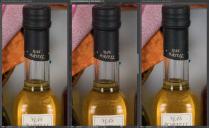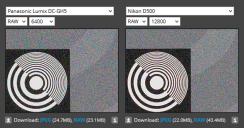
-
A brief look at a production model of the GH5:
-
GH5 demo reel filmed in Yokohama
-
It looks like the 100-400mm Leica is going to be a killer combo with the GH5 for 800mm eqiv handheld use !

 32547306153_9cd4ed8dfc_c.jpg800 x 500 - 106K
32547306153_9cd4ed8dfc_c.jpg800 x 500 - 106K -
@Kris great ISO, noise reduction and correction test.
-
@joe1946 can't wait to test that combo ;-)
-
There is something very fishy about Dpreview comparison tests. Some of their cameras (like the Nikon D500) are shot overexposed by 0,5 stops then corrected in LR with -0,5 stops, other cameras where underexposed then corrected in LR. For example, looking at Imaging Resource RAW comparisons, there is probably 1/3 of a stop difference in noise between D500 and GH5. When looking at Dpreview comparometer there is one full stop difference in noise between those cameras, but after I downloaded the original RAW's (for converting and comparing myself on the computer) I found this 0,7 stops exposure discrepancy between those two cameras.
What are your thoughts on the matter?

 D500 vs Gh5.jpg1595 x 976 - 921K
D500 vs Gh5.jpg1595 x 976 - 921K
 D500 ISO 6400.jpg1920 x 640 - 983K
D500 ISO 6400.jpg1920 x 640 - 983K
 GH5 ISO 6400.jpg1920 x 720 - 1M
GH5 ISO 6400.jpg1920 x 720 - 1M
 GH5 vs D500 on Dpreview.jpg587 x 308 - 169K
GH5 vs D500 on Dpreview.jpg587 x 308 - 169K -
@Vitaliy_Kiselev I'm assuming that's a handheld pan with the ibis. It still has that pan, drag, catch up, snap motion problem like the G85 had. The movement is stuttering throughout the whole pan. Is that acceptable for such a simple pan? I wouldn't be able use that footage in any of my work.
-
@hanriverprod It's just the old shutter angle (shutter speed) issue combined with it being a relatively fast hand held pan. Nothing to worry about.
-
@Eno Which RAW decoder are you using?
-
@caveport Adobe Camera RAW, but it does not matter, I get the same exposure differences using LR or RAWTherapee.
-

 sample919.jpg800 x 448 - 87K
sample919.jpg800 x 448 - 87K -
@caveport @hanriverprod i could not use that shot either. Can you get a proper Pan with Image stabilizer? could you please post a sample? Thanks a lot
-
Eno, maybe the exposure difference is due to the camera's ISO tuning? From DXO you can see how much manufactures shift their listed ISO from their measured actual ISO. For example the camera says 6400 ISO, but is measured to actually use 4283 ISO. It's like taking a shot at 3200 and in processing shift it's exposure slider. https://www.dxomark.com/Cameras/Compare/Side-by-side/Panasonic-Lumix-DC-GH5-versus-Nikon-D500-versus-Panasonic-Lumix-DMC-GX8___1149_1061_1041
I know DXO is not explaining their testing methods, but I believe the ISO shifting is a thing manufactures do to show low(er) noise results at high ISO to the public. This also may explain why there is less detail to be recovered from high ISO small pixel camera's because the shadows are already stretched into the midrange by the internal processing.
Either way I think the manufacturers are close to the limits of this type of sensor and processing, maybe they'll adopt a true new design within the next 2 years or so. I can think of one method to increase the dynamic range by having a different way of processing of sensor input.
-
@cas1 In the beginning I thought that to but the exposure differences are close to a stop and that's a huge difference. Samples from Imaging Resource or other review sites do not show such exposure differences between the cameras. I will do a test of my own between the two cameras after I receive the GH5 but something is fishy about Dpreview tests.
-
https://www.cinema5d.com/panasonic-gh5-lab-test-temporarily-offline/
"Due to the agitated discussion and hostility arising from our test of the Panasonic GH5, and our commitment to re-evaluating our test methodology based on reader comments, we have decided to temporarily remove this content while awaiting further feedback from the manufacturer. "
No feed back from Panasonic before the weekend as promised.
-
Panasonic Q&A @ CP+ 2017: The GH5 dev story, why no on-chip PDAF and how’d they make 4K affordable?
-
Even the very affordable FZ80 has it now. It's unusual to see 4K video in cameras less than $500, and we're curious what sort of challenges are associated with including 4K video and 4K Photo in such low-cost cameras? How have you managed to do it, but nobody else really has yet at that price point? Could it be that the processor that you developed for higher-end, you have manufactured long enough so the cost has come down?
Yeah, so not so hard for you. But it's surprised me a little bit, too, because Sony has also had a lot of experience in camcorders, but you have had much more 4K across your product line sooner than they did.
They literally lick their anus here. NX500 had been for quite a time cheaper than $500, and you really can't compare it to FZ80 crappy shit.
Specially for Image-Resource guys. Previously Panasonic LSI had been almost instantly shared among compacts, ultrazooms and mirrorless. Today it is not progress, but regress, where Panasonic is literally bleeding by not have enough scale. And GH5 price is indication of it.
For [typical] customers, V-Log L [is] too difficult, actually. V-Log L [is especially intended] for cinema people, [as] they like a very flat tone curve. For normal people and broadcasters, I think this function is not so interesting, and if we put V-log into [the cameras] without any charge, in that case it's a little bit difficult to explain how to use [it].
I also love how capitalists explain such things. Always good chance to laugh.
And also already we have 10-bit 4:2:2 [capture], two bits more dynamic range actually. And this means for even normal customers who want to get more dynamic range, they can use 10-bit.
"two bits more of dynamic range" mathematically means that dynamic range in 10bits is 4 times higher :-) . Actually whole phrase makes no sense, as you can push same sensor dynamic range even in 256bits.
-
While it makes not much sense how they say it, 2bits would be equal to two stops in linear light, you can't really tell for log without keeping the curve in mind. As VLOG L cuts off the upper part of the curve (which is available in the Varicam) it's harder to tell what they mean with that. But from the start, I think they don't mean anything and let the wrong person talk here :)
Howdy, Stranger!
It looks like you're new here. If you want to get involved, click one of these buttons!
Categories
- Topics List23,964
- Blog5,723
- General and News1,342
- Hacks and Patches1,151
- ↳ Top Settings33
- ↳ Beginners254
- ↳ Archives402
- ↳ Hacks News and Development56
- Cameras2,361
- ↳ Panasonic990
- ↳ Canon118
- ↳ Sony154
- ↳ Nikon96
- ↳ Pentax and Samsung70
- ↳ Olympus and Fujifilm99
- ↳ Compacts and Camcorders299
- ↳ Smartphones for video97
- ↳ Pro Video Cameras191
- ↳ BlackMagic and other raw cameras121
- Skill1,961
- ↳ Business and distribution66
- ↳ Preparation, scripts and legal38
- ↳ Art149
- ↳ Import, Convert, Exporting291
- ↳ Editors191
- ↳ Effects and stunts115
- ↳ Color grading197
- ↳ Sound and Music280
- ↳ Lighting96
- ↳ Software and storage tips267
- Gear5,414
- ↳ Filters, Adapters, Matte boxes344
- ↳ Lenses1,579
- ↳ Follow focus and gears93
- ↳ Sound498
- ↳ Lighting gear314
- ↳ Camera movement230
- ↳ Gimbals and copters302
- ↳ Rigs and related stuff272
- ↳ Power solutions83
- ↳ Monitors and viewfinders339
- ↳ Tripods and fluid heads139
- ↳ Storage286
- ↳ Computers and studio gear560
- ↳ VR and 3D248
- Showcase1,859
- Marketplace2,834
- Offtopic1,319












